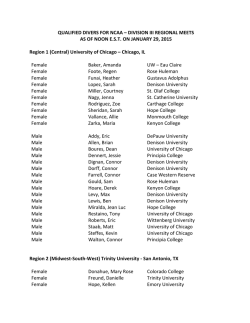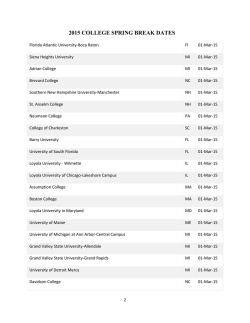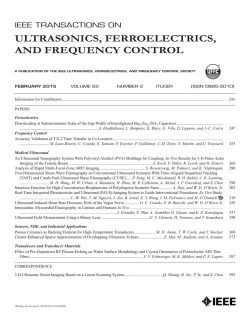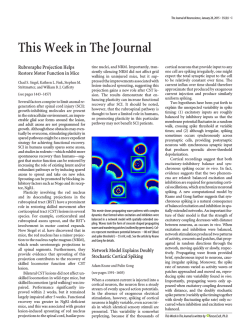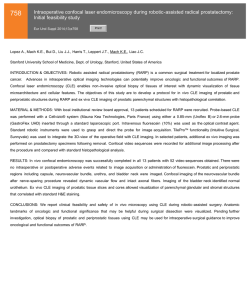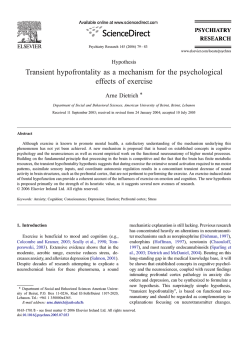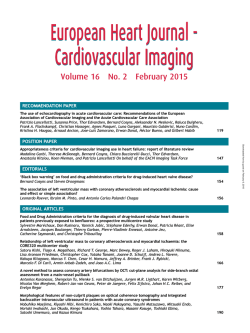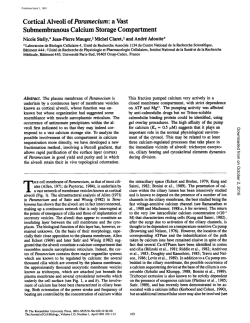
SUNY Brain Undergraduate Summer Scholars 2015 RFP
SUNY Brain Network of Excellence Undergraduate Research Summer Scholars Program Application Deadline: February 16, 2015 Term Period: (approximately) June, 1, 2015 – August 7, 2015 BACKGROUND SUNY and the Research Foundation for SUNY (RF) created the SUNY Networks of Excellence to facilitate systemwide collaboration and partnerships to share expertise and assets for innovative advances in research. By bringing together the varied expertise disbursed across the state into a collective network, SUNY can better leverage itself to become a more prominent national and international scientific leader, grow the number of research applications and awards, and educate the next-generation workforce. The SUNY Brain Network of Excellence (BNE) is designed to maximize interdisciplinary and collaborative neuroscience research across the SUNY campuses and facilitate partnerships with academia, industry, and the community. The BNE will supports research in two areas: 1) Fostering basic, translational and clinical research programs and partnerships that will create new knowledge and accelerate discovery in neuroscience research, and 2) Neuroscience education and research experiences for science, technology, engineering, and math (STEM) undergraduates within SUNY. PROGRAM FOCUS With funding provided by the RF, the SUNY Brain leadership team has created the SUNY Brain Summer Scholars Program to bring together undergraduate students who are considering a career in research and SUNY faculty who conduct research in neuroscience. No background in biology, life sciences or neuroscience is required for the program. We also encourage applications from students in engineering, physics and computation majors. The Summer Scholars Program is a ten week program that spans from June 1 to the first week of August 2015. PLEASE NOTE THAT PROGAM DATES VARY SLIGHTLY BY CAMPUS. Information about program dates can be found below. Students are placed in research laboratories at University at Albany, Binghamton University, University at Buffalo, Downstate Medical University, SUNY College of Optometry, Stony Brook University, and Upstate Medical University. PARTICIPANTS RECEIVE: Stipend: $3,500 Housing will be provided at most SUNY campuses. Housing cannot be provided at SUNY College of Optometry in Manhattan and a $1500 housing allowance can be provided for students at who work at SUNY College of Optometry laboratories. REQUIREMENTS: 1 Applicants must be presently enrolled in a SUNY institution and have completed 4 semesters of college. (Preference will be given to applicants in their Junior year at the time of application. Students graduating in May 2015 are not eligible.) Underrepresented minority students are encouraged to apply. A brief personal statement in which the student discusses the reasons he/she wishes to participate in the program. A copy of the student’s undergraduate transcripts. A confidential letter of recommendation from a professor or other professional (sent directly from the recommender) that discusses the student’s potential for a research career. Ranking of top four research locations from opportunities listed on the following pages. TIMELINE Completed applications and supporting documents must be submitted by February 16 2015. Applicants will be notified of the status of their acceptance by March 9, 2015. DIRECTIONS FOR STUDENTS TO APPLY: Please go to the following link to apply for the SUNY Brain Summer Scholars Program: https://www.grantinterface.com/rfsuny/Common/LogOn.aspx You will be prompted to create an account, for which your first name, last name, email address, and mailing address will be requested. Once you’ve created your account, you may click on the ‘Apply’ link under the ‘Requests’ tab on the left-hand side of the screen. To access the Brain Summer Scholars Program application, enter the code “BNESUMMER” into the access code box. FOR ADDITIONAL INFORMATION ABOUT HOW TO APPLY: Please view the editorial provided on pages 14-15 of this RFP. RESEARCH LABS Descriptions and locations of the opportunities that are available in 2015 program are listed on the following pages. Applicants are required to select their top four choices in the online application. QUESTIONS For further information, please contact Angela Wright at [email protected] or (518) 434-7061. 2 RESEARCH LAB PROFILES List A: University at Albany Program: REU http://www.wadsworth.org/educate/molcel.htm 6/1 – 8/7/15 Annalisa Scimemi Department of Biology My lab is interested in developing novel computational tools to analyze the structure of synapses and the behavior of mouse models of neuropsychiatric disorders. The other experimental approaches used in the lab include electrophysiology, molecular biology and two photon calcium imaging. For more info, visit the website: https://sites.google.com/site/scimemilab2013/home Binghamton University Program: SSAP http://www.binghamton.edu/undergraduate-research-center/summerscholars-and-artists-program/ 8 weeks June-July Patricia M Dilorenzo Department of Psychology My research interests lie in the area of neural coding in sensory systems. Using the gustatory system as a model, my graduate students and I have pursued two separate but interrelated strategies. First, we have presented the system with an array of natural stimuli, i.e. examples of various taste qualities, and recorded the electrophysiological responses from taste-sensitive neurons in anesthetized and awake, freely-licking rats. By the analysis of the spike trains evoked in small groups of simultaneously recorded neurons, we have been able to deduce some of the interrelationships among taste cells that produce their characteristic sensitivity patterns. As part of this effort, we have proposed a neural network model of taste processing in the brain stem. Although it is still evolving, our model demonstrates the possibility that some of the well-studied features of taste-responsive neurons may actually be emergent properties of network processing, rather than intrinsic characteristics. As a second, complimentary strategy we have driven taste-related neurons with electrical pulses presented in a temporal sequence that mimics the temporal pattern of the neural response to a natural tastant. We then assess the evoked sensation in terms of its similarity to a natural taste. By systematically varying the temporal parameters of this artificial stimulus, i.e., the electrical stimulation, we hope to discover which aspects of the neural response evokes the various characteristics of a taste perception. http://www2.binghamton.edu/psychology/people/faculty/patricia-dilorenzo.html Downstate Medical Center Program: Summer Research Program for Undergraduates http://www.downstate.edu/grad/fellowship.html 8 weeks June-July Youping Xiao Department of Ophthalmology 3 The primate visual system is comprised of more than 30 cortical areas and sub-cortical structures, each of which is comprised of multiple layers. It is one of the most challenging questions in neuroscience that how this multi-stage system processes information received by the eyes and produces our visual perception. Dr. Xiao's laboratory tackles this question by studying the neural mechanism of color vision. He has previously discovered hue maps in visual areas V1 and V2 (Xiao et al., 2003, 2007). These hue maps are likely the origin of hue maps in higher visual areas where electrical stimulation elicits the precept of specific colors. Using 64-channel electrode recoding system and computational approaches, Dr. Xiao's lab is currently addressing how the multi-layer circuit in V1 constructs the hue maps, what features are added to hue maps in higher areas, and how the addition or refinery is computed by the neural circuits. Answers to these questions are crucial for the understanding of function of different areas and layers, which in turn is important for diagnosis and treatment of cortical deficits and the development of neural prosthesis. In addition, his lab is developing cortical visual prosthesis with optogenetics. This novel approach has enormous therapeutic potential for blind patients, especially those without a functioning retina. A summer student will learn cutting-edge technologies of electrophysiology and brain imaging, and contribute to quantitative data analyses. Xiao Y, Wang Y, Felleman DJ. A spatially organized representation of color in macaque area V2. Nature 2003; 421:535-539. Xiao Y, Casti A, Xiao J, Kaplan E. Hue maps in primate striate cortex. NeuroImage 2007; 35: 771-786. http://www.downstate.edu/ophthalmology/faculty/xiao.html SUNY College of Optometry Program: CSTEP http://www.sunyopt.edu/education/admissions/cstep 8 weeks June-July Please note that housing is not available at this campus. Jose-Manuel Alonso Department of Biological Sciences My laboratory is interested in understanding how visual information is represented in the brain. Visual processing is mediated by two major brain pathways that signal light increments (ON) and decrements (OFF) in the visual scene. In mammals, ON and OFF channels remain segregated in thalamus and combine for first time in visual cortex, however, the ON-OFF mixing is not complete; it is partial and unbalanced. Our work demonstrates that ON and OFF pathways remain partially segregated in cortex and that the OFF pathway makes stronger connections and occupies a larger territory in the cerebral cortex than the ON pathway. Moreover, we found that cortical responses to dark stimuli (e.g. a fly in the blue sky) are stronger, faster, more linearly related to luminance contrast and have better spatial and temporal resolution than responses to light stimuli (e.g. a star in the night). Finally, our recent results indicate that the dominance of the OFF pathway is continuously adjusted based on the spatial frequency content of the visual scene (e.g. the OFF dominance increases when you remove your glasses and images become blurred). These results suggest that the visual cortex processes images very differently from human-made algorithms that are regularly applied to astronomy, medicine and telecommunication. While human-made algorithms extract all possible combinations of dark and light stimuli in the visual scene, the visual cortex gives priority to dark stimuli and continuously adjusts its image processing algorithms based on the statistics of the visual scene. Summer students will be involved in analysis of visual responses from large populations of neurons in visual cortex and/or psychophysical experiments that aim to demonstrate the consequences of dark/light asymmetries in vision and to guide the development of new diagnostic tools for visual disease. Some relevant references to read are: 4 1) Kremkow, J., J. Jin, S. J. Komban, Y. Wang, R. Lashgari, X. Li, M. Jansen, Q. Zaidi and J. M. Alonso (2014). Neuronal nonlinearity explains greater visual spatial resolution for darks than lights. Proceedings of the National Academy of Sciences of the United States of America 111(8): 3170-5. PMCID: 3939872. This paper received extensive press coverage. It was in Google News for three days, ranked second after the press release and as ‘most popular’ on the second day. PNAS ranks the online impact of this paper on the top 99% compared to all 20,600 articles published in this Journal. See metrics in http://www.pnas.org/content/early/2014/02/05/1310442111.abstract 2) Komban, S. J., J. Kremkow, J. Jin, Y. Wang, R. Lashgari, X. Li, Q. Zaidi and J. M. Alonso (2014). Neuronal and perceptual differences in the temporal processing of darks and lights. Neuron 82(1): 224-34. PMCID: 3980847. 3) Wang, Y., J. Jin, J. Kremkow, R. Lashgari, S. J. Komban and J. M. Alonso (2014). Columnar organization of spatial phase in visual cortex. Nature neuroscience. PMID: 25420070. 4) Jin, J. Z., Weng, C., Swadlow, H.A., Alonso, J.M. (2011) Population receptive fields from ON and OFF thalamic inputs to an orientation column in cat visual cortex Nature Neuroscience 14(2): 232-8. News and Views associated to this paper: Ringach, D. L. (2011). You get what you get and you don't get upset. Nature Neuroscience 14(2): 123-4. Martinez, L.M. (2011). A new angle on the role of feedforward inputs in the generation of orientation selectivity in primary visual cortex. J. Physiol. 589(12): 2921-2. 5) Jin, J. Z., C. Weng, C. I. Yeh, J. A. Gordon, E. S. Ruthazer, M. P. Stryker, H. A. Swadlow and J. M. Alonso (2008). On and off domains of geniculate afferents in cat primary visual cortex. Nature Neuroscience 11(1): 88-94. PMCID: 2556869. (Cover of this Nature Neuroscience issue and cover that represented Nature Neuroscience in the 2009 Calendar of Nature Journals). http://www.sunyopt.edu/research/about_our_research/graduate_faculty/jose_manuel_alonso Stewart Bloomfield College of Optometry The work in our laboratory is directed at understanding the cellular mechanisms of information processing and neuronal communication in the retina. We use a wide range of techniques including patch clamp and multi-electrode array recordings, confocal and multi-photon microscopy, immunocytochemistry, and visual behavior using a number of transgenic and gene knockout mouse models. Recently my lab has focused on the role of gap junctions and electrical synaptic transmission in the retina showing that they play a multitude of important roles in image processing including contrast sensitivity, neural adaptation, as well as multiplexing of visual information across the optic nerve. We also carry out translational research on the role of gap junctions in secondary cell death associated with a variety of neurodegenerative diseases of the retina including ischemic retinopathy and glaucoma. We are currently examining whether gap junctions form a novel therapeutic target to protect neurons and thereby preserve vision in subjects with retinal neurodegenerative disease. Finally, we are studying the genetic and environmental factors that lead to the onset and progression of myopia (nearsightedness) that affects nearly 40% of adolescents in the U.S. There are thus numerous research opportunities for a summer student to engage in basic and/or translational research projects in the lab. http://www.sunyopt.edu/directory/profile/stewart_bloomfield 5 Stony Brook University Program: URECA http://www.stonybrook.edu/ureca/ June 1 – Aug 7, 2015 Christine DeLorenzo Department of Psychiatry The Center for Understanding Biology using Imaging Technology (CUBIT) is a laboratory dedicated to understanding the neurobiology of mental illness. Because diseases such as depression, bipolar disorder, post traumatic stress disorder (PTSD) and others are complex, heterogeneous illnesses, they require a greater understanding of the brain in order to improve diagnosis and treatment. We obtain this increased understanding using multimodal imaging, including Positron Emission Tomography (PET) and Magnetic Resonance Imaging (MRI) methods. PET allows the visualization and quantification of neurotransmitter systems. MRI provides high-resolution images of brain structure. The BNE summer student will learn the techniques used to acquire and analyze PET and MRI images. They will then apply image processing and engineering techniques to combine information from multiple imaging modalities to uncover the biological differences associated with depression and other disorders. http://medicine.stonybrookmedicine.edu/psychiatry/faculty/delorenzo_c Andrew Goldfine Department of Neurology I'm a neurologist at Stony Brook Medicine interested in recovery of cognitive and behavioral deficits after stroke and traumatic brain injury. My work primarily involves multi-modal brain imaging (EEG, MRI, PET) on patients during the recovery process to better understand the dysfunctional brain networks underlying their abnormal behavior / cognition. I have multiple projects in mind that would be relevant to the fields mentioned in the announcement. For example, my main modality is quantitative EEG. This is a very powerful tool that allows us to look at brain function in real time, and at the patient's bedside (I study patients who are hospitalized for an acute stroke). Despite EEG being around for 100 years, it's role as a brain imaging tool is still in it's infancy and there is a large need for engineering / computer science / physics approaches to improve the analysis pipeline and develop new analytical approaches. One project could be to develop a real-time analysis tool to look at dysfunctional brain areas in patients with acute stroke. There is data now that suggests this can identify patients having progression of stroke (a medical emergency), and that the EEG can identify it possibly hours before a nurse can. If a student was more interested in developing new analytic approaches, that would also be an option for them. I also am doing work with MRI and PET to look at brain function after stroke and can offer student the opportunity to work on this data in collaboration with physicists that I collaborate with (the physicists are in the departments of radiology and psychiatry and are located in the same floor as I sit so is a natural collaboration). http://neuro.stonybrookmedicine.edu/physicians/Andrew-Goldfine-MD.html Hoi-Chung Leung Department of Psychology The lab uses functional magnetic resonance imaging (fMRI) approaches to study the neural basis of human cognition including working memory and cognitive control. We have many STEM appropriate projects that involves matlab coding and neuroimage processing and modeling. We apply multivariate analysis to model fMRI data in order to study the relationship between brain function, physiology and behavior. We also examine the implications of our work 6 in special populations including children at risk of depression, adults with depression and patients with Parkinson's disease. A summer student can work in collaboration with existing members of the lab or independently, depending on experience. http://www.psychology.sunysb.edu/cns Jerome Liang Department of Radiology Program: This program was established in 1992 within the Department of Radiology, Health Sciences Center (HSC) of the State University of New York at Stony Brook - SUNY. The program is housed in a laboratory, which is equipped with state-of-the-art super computers and associated facilities, and has been conducting several internationally recognized research projects. The major task of this program is the development of methodology for early diagnosis of diseases, such as cancer, cardiac malfunction, neural disorder, etc. As the laboratory's title "Laboratory for Imaging Research and Informatics (IRIS)" says, the program develops and utilizes advanced imaging techniques to acquire the intrinsic (internal) information from the patient, applies basic sciences to analyze the information, and integrates physician's assessment into the final decision making. Early detection of a disease sign is extremely important to save the patient and cut down the cost and is also extremely difficult because of lacking any symptom. The task of this program serves the national and international public interest. Research Activities: (1) Developing Virtual Colonoscopy for Colon Cancer Screening Colon cancer is the second leading cause of cancer related deaths in this nation. Detection and removal of the colonic polyps will totally save the patient. We have patented and developed virtual colonoscopy technology for colon screening. Clinical trial of this technology is currently under progress. (2) Screening Lung Cancer by Ultra Low-Dose Computed Tomography Lung cancer remains the leading cause of cancer related deaths worldwide, despite many years effort attempting to prevent and cure it. Computed tomography (CT) is the current choice of imaging modality for lung information mapping. We have been exploring the utility of CT at as low as achievable dose level for various clinical tasks in lung cancer prevention and treatment, and good progress is being made. (3) Quantitative SPECT Reconstruction of the Chest and Brain Single photon emission computed tomography (SPECT) is a cost-effect, non-invasive, risk-free imaging modality for studies of tissue/organ functionality. We have contributed significantly to the development of this modality for studies of the heart, lungs, brain and breasts. The clinical relevance of this project is that (1) heart disease is the number killer in the United States, (2) lung cancer is the leading cause of cancer related deaths in this nation, (3) neural disorders impose a great burden to the family and society (i.e. affect a large segment of patients for a relatively long lifetime and, therefore, render a great cost), and (4) breast cancer is also the leading cause of cancer-related deaths in this nation for women. (4) Quantifying brain function and anatomy by MRI Brain atrophy is a very common indicator for various neural disorders. We have been interested in quantifying the brain anatomy to measure subtle changes in the sub-structures within the white matter and grey matter. In addition, we have been interested in integrating the brain function to the subtle changes to classify disease types. An example is the classification of multiple sclerosis (MS). Another example is the quantification of arterial spin labeling (ASL) perfusion. www.mil.sunysb.edu/iris/jzl/jzl.html 7 Upstate Medical University Program: SURF http://www.upstate.edu/grad/programs/summer.php June 1 – Aug 7, 2015 Peter Calvert Department of Ophthalmology The Calvert lab studies the dynamics of proteins in live retinal photoreceptors and other ciliated cells to determine how they are transported to and localized within subcellular compartments. His lab has developed novel, quantitative tools that are being used to probe the dynamics of specific proteins within the living cells in which they normally reside and to determine how mutations that lead to disease cause the proteins to misbehave. Integral to this approach is the use of multiphoton and confocal optical methods to image molecules within living cells from transgenic animals, or in cell culture, that express proteins fused to fluorescent tags. Multiphoton fluorescence relaxation after photoconversion and single molecule tracking using quantum dots are employed to examine protein transport. Fluorescence cross correlation spectroscopy and multiphoton fluorescence lifetime imaging are used to examine protein-protein interactions. Investigating the dynamics of normal proteins within cells and how they change when mutated will lead to a better understanding of the mechanisms underlying devastating blinding diseases, such as retinitis pigmentosa, as well as other ciliopathies, and may ultimately lead to new therapeutic strategies. http://www.centervisionresearch.org/Investigators/Peter-D.-Calvert-Ph.D Christopher Neville CHP-Physical Therapy Traumatic brain injury (TBI) is a major health problem, especially among male adolescents and young adults. Mild traumatic brain injury (mTBI) often goes undetected or unmanaged, as the effects of brain injury are often difficult to visualize. Clinical management of patients is largely guided by clinician experience and self-reported symptoms rather than objective assessment. There is a lack of commercially available objective assessments that can be used outside of a laboratory setting. Upstate Medical University with Drs. Neville and Rieger have partnered with Motion Intelligence, LLC to developed a prototype portable system (referred to as the Mi Care System) that integrates a microelectromechanical system (MEMS) inertial sensor and digital cognitive tests, which can provide objective metrics useful to advance the clinical care for mTBI. The system uses specific objective balance and cognitive metrics that are validated against goldstandard laboratory measures. These include novel digital cognitive tests paired with an inertial sensor to measure dual-task (balance and cognition) performance. A summer Scholar would engage in ongoing management of balance, cognitive, and dual-task data to examine test properties, stability, learning effects, and injury recognition patterns across a study sample of healthy controls and patients post-mTBI. http://www.upstate.edu/search/?tab=people&ID=nevillec Eric Olson Department of Neuroscience & Physiology We are using multiphoton microscopy to create movies of early cerebrocortical development. These studies are providing key insights into the cellular dynamics underlying the establishment of cortical circuits. We are able to observe the extension and retractions of the finest dendritic filopodia and ask how these filopodia react to neighboring axons or respond to environmental cues or toxins. These interactions anticipate later synapse formation. 8 We currently have projects examining the role of Reelin signaling in promoting cellular polarity, golgi deployment and directional dendritic growth. Using conditional knockout mice, we are examining the role of the focal adhesion adaptor proteins Hic5 and Paxillin in this process of cortical migration and elaboration of the dendrite. Finally we are studying the consequence of ethanol exposure on directional dendritic growth. Our laboratory has expertise in neurodevelopment, Reelin-signaling, multiphoton imaging, confocal imaging and image analysis. http://www.upstate.edu/search/?tab=people&ID=olsone Daniel Tso Department of Neurosurgery The long-term goal of our work is to arrive at a deeper understanding of the neural mechanisms underlying visual perception. Although we have chosen to focus on the processing in the visual system, the mechanisms of neuronal organization, interaction and connectivity that we are studying hold broad implications for our understanding of brain in both normal and diseased states. Important themes include the classes of neuronal interactions between different cortical areas, and how ensembles of neurons cooperate to ultimately yield visual perception, object recognition and visually-guided behavior. Our studies employ a range of anatomical and physiological techniques, including single and multiple electrode recordings, optical functional imaging and multi-photon imaging. Our most recent projects include functional retinal imaging in humans and other species, and a study of the mechanisms underlying rapid adult cortical plasticity. http://www.upstate.edu/search/?tab=people&ID=tsod Andrea Viczian Department of Ophthalmology Cone photoreceptors make up less than 5% of retinal cells, yet they are responsible for all our daylight vision. Once cones are lost, there is currently no way to replace them. Our approach is to find a way to generate a plentiful population of these rare, sight-saving cells. The BNE summer student would work together with a graduate student and the PI on a tissue engineering project over the summer, looking at how the environment influences cone photoreceptor formation in culture. http://www.upstate.edu/search/?tab=people&ID=vicziana 9 RESEARCH LAB PROFILES List B: University at Albany Program: REU http://www.wadsworth.org/educate/molcel.htm 6/1 – 8/7/15 Gerwin Schalk Research Scientist, Wadsworth Center The Adaptive Neurotechnologies Program at the Wadsworth Center is conducting research in three major areas and is translating the results into useful clinical applications. (1) Operant conditioning of simple spinal cord reflexes to improve rehabilitation of important motor skills such as locomotion. We showed for the first time that the simplest spinal reflex pathways can be modified by operant conditioning (e.g., J Neurophysiol 50:1296-1311, 1983). We are elucidating the anatomical and physiological mechanisms of this plasticity and are showing that appropriate modifications of reflex pathways can improve walking in animals and humans with spinal cord injuries (e.g., J Neurosci 26:12537-12543, 2006; 33:2365-2375, 2013). This work opens an entirely new approach to neurorehabilitation through targeted modifications of CNS pathways. We are now extending it to additional pathways and focusing it on specific phases of dynamic behaviors. http://www.wadsworth.org/resnres/bios/schalk.htm University at Buffalo Richard Gronostajski Department of Biochemistry The Gronostajski lab studies the biology of neural stem cells and how those cells differentiate into all of the neurons and glia in the brain. We have a particular focus on adult neural stem cells and how they are regulated by transcription factors. Our summer project would involve culturing neural stem cells from adult mouse brain and assessing the differentiation potential of both normal neural stem cells and stem cells lacking the Nuclear Factor I X (NFIX) transcription factor. http://medicine.buffalo.edu/content/medicine/faculty/profile.html?ubit=rgron Zhen Yan Department of Physiology and Biophysics The laboratory of Dr. Zhen Yan in SUNY-Buffalo is interested in discovering the molecular and cellular mechanisms of mental disorders. Particularly, we study the synaptic action of various neuromodulators that are linked to mental health and illness, including dopamine, stress hormones, and disease susceptibility genes. We try to understand how these neuromodulators regulate glutamatergic and GABAergic transmission in prefrontal cortex (PFC), which is important for emotional and cognitive control under normal conditions. We also try to understand how the aberrant action of neuromodulators under pathological conditions leads to dysregulation of synaptic transmission in PFC, which is commonly implicated in mental disorders including ADHD, schizophrenia, depression, and autism. By using a combination of electrophysiological, molecular biological, biochemical and behavioral approaches, we have been tackling the unique and dynamic actions of neuromodulators on the trafficking and function of glutamate and GABA receptors in normal animals and different disease models. 10 http://medicine.buffalo.edu/content/medicine/faculty/profile.html?ubit=zhenyan Steven J. Fliesler Departments of Ophthalmology & Biochemistry My research involves retinal biochemistry and cell biology within the context of hereditary and acquired retinal degenerations, using animal models to mimic human diseases. In particular, my lab has focused on studying how dysregulation of cholesterol metabolism impacts the development and maintenance of normal retinal structure and function. We use a combination of lipidomic, proteomic, and genomic approaches, in conjunction with histological, immunohistochemical, and ultrastructural (EM) methods, to elucidate the underlying mechanisms that cause retinal degenerations in animal models of human diseases. Other scientific interests include the impact of protein and lipid oxidation on the structure/function of the retina, and the application of antioxidants as therapeutic interventions for retinal/neuronal degenerations. My lab collaborates and co-publishes actively and effectively with a number of other laboratories (see PubMed: http://www.ncbi.nlm.nih.gov/pubmed/?term=Fliesler+SJ), particularly as regards the use of EM and EM immunogold cytochemistry methods to contribute substantively to those collaborations. A number of projects are potentially available for students to pursue, either independently or in collaboration with other personnel in the lab. For additional information, see: http://medicine.buffalo.edu/content/medicine/faculty/profile.html?ubit=fliesler and http://www.sunyeye.org/users/view/129. Margarita Dubocovich Department of Pharmacology and Toxicology Molecular Modeling Predicts Affinity of Environmental Toxins for Human and Mouse MT1 and MT2 Melatonin Receptors Mentors: Drs. Margarita L. Dubocovich/Rajendram V. Rajnarayanan, Department of Pharmacology and Toxicology, School of Medicine and Biomedical Sciences, University at Buffalo Introduction: Melatonin is a hormone synthesized by the pineal gland, in a circadian fashion with high levels during the night and low levels during the day. Melatonin signals through two G protein coupled receptors, known as MT1 and MT2. Disruption of the circadian rhythm has been linked to diabetes and other disorders. Molecular modeling has identified possible circadian disruptors, including two classes of pesticides: carbamates and pyrethroids. Project Goals: To dock compounds into MT1 and MT2 melatonin receptor molecular models to assess binding in silico and translate to in vitro receptor binding studies; To determine the affinity and selectivity of selected compounds for the MT1 and MT2 melatonin receptors; To determine differences in affinity and selectivity between human and mouse MT1 and MT2 melatonin receptors Degree of Independence Expected: The student will work closely with Dr. Dubocovich, Dr. Rajnarayanan, and a senior graduate student or postdoc, who will mentor and guide the student in daily laboratory activities. The student will be trained in all the molecular and biochemical techniques necessary to conduct the project and will be taught the principles of hypothesis driven research, drug-receptor interaction, and data analysis. We will provide guidance in all aspects of the work in areas including literature searches, laboratory techniques, preparation of written reports and research presentations. At the end of the summer, we expect that the student will be able to run the experiments and analyze the data with minimal supervision from us. The student will participate in all activities of the CLIMB UP for Summer Research at UB. http://medicine.buffalo.edu/content/medicine/faculty/profile.html?ubit=mdubo 11 Rajendram V. Rajnarayanan Department of Pharmacology and Toxicology Environmental chemicals targeting human melatonin receptors Exposure to environmental chemicals is a major concern for human health as natural and man-made substances can adversely affect physiological processes which may contribute to the incidence of various diseases ranging from neurodegenerative diseases to metabolic syndrome. Our lab seeks to identify neuroendocrine disruptors affecting the circadian hormone melatonin and its ability to signal "time-of-day" messages to target peripheral tissues. The release of melatonin from the pineal gland is regulated by biological clocks in the suprachiasmatic nucleus (SCN) of the hypothalamus which in turn regulates peripheral target tissues through activation of MT1 and MT2 melatonin receptors. We use an integrated pharmacoinformatics approach to identify environmental circadian disruptors that target hMT1 and hMT2 melatonin receptors. Many of these chemicals are flying under the toxicological radar and have no established guidelines for exposure. Our integrated Chem2Risk strategy will provide the essential impetus to pursue further testing in animal models and be useful in future assessment of risk factors associated with environmental disruptors carrying similar chemical-structural features and to establish exposure regulatory guidelines. Degree of Independence Expected: The student will work closely with Dr. Rajnarayanan, and a senior graduate student or postdoc, who will mentor and guide the student in daily laboratory activities. The student will be trained in all the molecular and biochemical techniques necessary to conduct the project and will be taught the principles of hypothesis driven research, drug-receptor interaction, and data analysis. We will provide guidance in all aspects of the work in areas including literature searches, laboratory techniques, preparation of written reports and research presentations. At the end of the summer, we expect that the student will be able to run the experiments and analyze the data with minimal supervision from us. The student will participate in all activities of the CLIMB UP for Summer Research at UB. http://medicine.buffalo.edu/content/medicine/faculty/profile.html?ubit=rajendra Ji Li Department of Pharmacology and Toxicology We have developed a comprehensive heart perfusion system to study the signaling mechanism of pharmacological therapy. The project that the summer students will be working on test the cardioprotective effects of some natural products from herb medicine on ischemic heart disease and heart failure. As PI or co-investigator on several AHA-, ADA-, and NIH-funded grants, I laid the groundwork for the ongoing research by spearheading novel projects related to understanding the role of stress signaling pathways in glucose metabolic regulation. In addition, I successfully administered the projects (e.g. staffing and budget), collaborated with other researchers, and produced several peerreviewed publications from each project. I would be happy to supervise the summer students who are working at my laboratory with four graduate students, three fellows and two technicians. The student will participate in all activities of the CLIMB UP for Summer Research at UB http://medicine.buffalo.edu/content/medicine/faculty/profile.html?ubit=jli23 SUNY College of Optometry 12 Benjamin Backus Graduate Center for Vision Research Benjamin Backus's lab at SUNY College of Optometry conducts research on binocular vision in normally sighted people and looks for new treatments for binocular anomalies such as amblyopia and strabismus. An important project this summer will test whether amblyopia treatments in adults can be made more effective by spending 10 days in complete darkness. 8 adult volunteers will undergo pretesting, binocular deprivation for 10 days, training, and posttesting. This project involves spending time in the dark with the participants and providing support, in addition to scientific help. In animal models, visual deprivation was recently shown to be sufficient to reinstate juvenile plasticity in visual cortex, with a resulting substantial recovery from deep amblyopia. We are looking for team members who have a strong interest in neuroscience, good team member skills, and a sense of adventure. 13 SUNY Brain and SUNY 4E Summer Scholars Programs How to access the application 1. Visit: https://www.grantinterface.com/Common/LogOn.aspx?eqs=ph_BjRFP96v7pK3S5uUjYg2 2. Create and account and/or log in. 3. Click Apply. 4. Enter BNESUMMER or 4ESUMMER in the Access Code box and click Enter. 14 5. Click the link that appears to open the application. Depending on your settings, you may need to cut and paste the link it into a new browser. 15
© Copyright 2024
